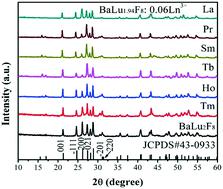当前位置:
X-MOL 学术
›
CrystEngComm
›
论文详情
Our official English website, www.x-mol.net, welcomes your feedback! (Note: you will need to create a separate account there.)
Hydrothermal synthesis of BaLu2F8:Ln3+ crystals: phase/morphology evolution, energy transfer and tunable multicolor luminescence
CrystEngComm ( IF 3.1 ) Pub Date : 2020-06-25 , DOI: 10.1039/d0ce00818d Jie Xiong 1, 2, 3, 4, 5 , Wei Wang 1, 2, 3, 4, 6 , Yini Mao 1, 2, 3, 4 , Qingyuan Liu 1, 2, 3, 4 , Jun Yang 1, 2, 3, 4 , Jianfeng Tang 2, 3, 4, 7 , Shanshan Hu 1, 2, 3, 4
CrystEngComm ( IF 3.1 ) Pub Date : 2020-06-25 , DOI: 10.1039/d0ce00818d Jie Xiong 1, 2, 3, 4, 5 , Wei Wang 1, 2, 3, 4, 6 , Yini Mao 1, 2, 3, 4 , Qingyuan Liu 1, 2, 3, 4 , Jun Yang 1, 2, 3, 4 , Jianfeng Tang 2, 3, 4, 7 , Shanshan Hu 1, 2, 3, 4
Affiliation

|
BaLu2−xF8:xLn3+ crystals have been synthesized via a one-step hydrothermal route without any surfactants. X-ray diffraction (XRD), scanning electron microscopy (SEM), and down-shift/up-conversion photoluminescence spectroscopy were used to characterize the samples. Pure monoclinic BaLu2F8 crystals were obtained at pH = 7 with NaBF4 as a fluoride source. Doping 0.06 mmol Ln3+ ions from Ho3+ to La3+ and doping Yb3+ ions from 0.1 to 0.4 mmol both have caused dramatic changes to the product's morphology from prismatic microrods of about 10 μm to particles of about 3 μm aggregated by flakes. The differences in the phase, size and shape of the final products were greatly related to the fluoride source and pH values, which have been studied in detail. In addition, surfactants also affected the phase and morphology of the BaLu2F8 crystals. Multicolor down-shift emission was achieved in the BaLu1.94F8:0.06Ln3+ (Ln = Sm, Eu, Tb, Dy, Er and Tm) crystals under UV lamp excitation at 365 nm, and multicolor UC luminescence has been achieved in BaLu2F8:Yb3+,Ln3+ (Ln = Er, Tm, Ho) systems. When the Yb3+–Er3+ ions are co-doped into the host, the mechanism for the red emission (4F9/2 → 4I15/2) retains the tri-photon process like the single-doped Er3+ ion, but the mechanism for the green emission (2H11/2/4S3/2 → 4I15/2) is a two-photon process. Furthermore, the UC luminescence mechanism for the co-doped Yb3+–Ho3+ pairs is also a tri-photon process in the BaLu2F8 matrix. The as-prepared BaLu2F8:Ln3+ phosphors have potential applications in the fields of light emitting devices, three-dimensional displays and backlights.
中文翻译:

BaLu2F8:Ln3 +晶体的水热合成:相/形貌演化,能量转移和可调多色发光
BaLu 2- x F 8:x Ln 3+晶体是通过一步水热法合成的,没有任何表面活性剂。X射线衍射(XRD),扫描电子显微镜(SEM)和下移/上转换光致发光光谱法用于表征样品。以NaBF 4为氟化物源,在pH = 7时获得纯单斜BaLu 2 F 8晶体。从Ho 3+向La 3+掺杂0.06 mmol Ln 3+离子并掺杂Yb 3+从0.1到0.4 mmol的离子都会引起产品形态的急剧变化,从大约10μm的棱柱形微棒到薄片状聚集的大约3μm的颗粒。最终产品的相,大小和形状的差异与氟化物来源和pH值有很大关系,对此已进行了详细研究。另外,表面活性剂还影响BaLu 2 F 8晶体的相和形态。在365 nm的UV灯激发下,BaLu 1.94 F 8:0.06Ln 3+(Ln = Sm,Eu,Tb,Dy,Er和Tm)晶体实现了多色下移发射,并且在1989年实现了多色UC发光。巴鲁2 F 8:Yb 3+,Ln 3+(Ln = Er,Tm,Ho)系统。当镱3+ -Er 3+离子共掺杂到宿主,该机构用于红色发光(4 ˚F 9/2 → 4我15/2)保持一样的单掺杂的铒三光子过程3 +离子,但绿色发射的机理(2 H 11/2 / 4 S 3 / 2 → 4 I 15/2)是一个双光子过程。此外,BaLu 2中共掺杂的Yb 3+ -Ho 3+对的UC发光机理也是三光子过程。F 8矩阵。所制备的BaLu 2 F 8:Ln 3+磷光体在发光器件,三维显示器和背光源领域具有潜在的应用。
更新日期:2020-07-27
中文翻译:

BaLu2F8:Ln3 +晶体的水热合成:相/形貌演化,能量转移和可调多色发光
BaLu 2- x F 8:x Ln 3+晶体是通过一步水热法合成的,没有任何表面活性剂。X射线衍射(XRD),扫描电子显微镜(SEM)和下移/上转换光致发光光谱法用于表征样品。以NaBF 4为氟化物源,在pH = 7时获得纯单斜BaLu 2 F 8晶体。从Ho 3+向La 3+掺杂0.06 mmol Ln 3+离子并掺杂Yb 3+从0.1到0.4 mmol的离子都会引起产品形态的急剧变化,从大约10μm的棱柱形微棒到薄片状聚集的大约3μm的颗粒。最终产品的相,大小和形状的差异与氟化物来源和pH值有很大关系,对此已进行了详细研究。另外,表面活性剂还影响BaLu 2 F 8晶体的相和形态。在365 nm的UV灯激发下,BaLu 1.94 F 8:0.06Ln 3+(Ln = Sm,Eu,Tb,Dy,Er和Tm)晶体实现了多色下移发射,并且在1989年实现了多色UC发光。巴鲁2 F 8:Yb 3+,Ln 3+(Ln = Er,Tm,Ho)系统。当镱3+ -Er 3+离子共掺杂到宿主,该机构用于红色发光(4 ˚F 9/2 → 4我15/2)保持一样的单掺杂的铒三光子过程3 +离子,但绿色发射的机理(2 H 11/2 / 4 S 3 / 2 → 4 I 15/2)是一个双光子过程。此外,BaLu 2中共掺杂的Yb 3+ -Ho 3+对的UC发光机理也是三光子过程。F 8矩阵。所制备的BaLu 2 F 8:Ln 3+磷光体在发光器件,三维显示器和背光源领域具有潜在的应用。


























 京公网安备 11010802027423号
京公网安备 11010802027423号